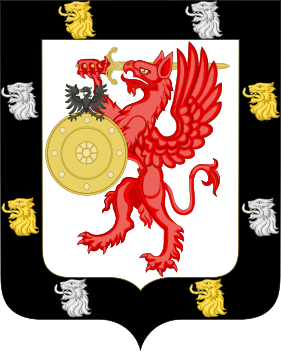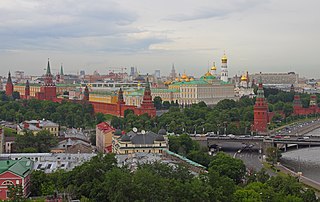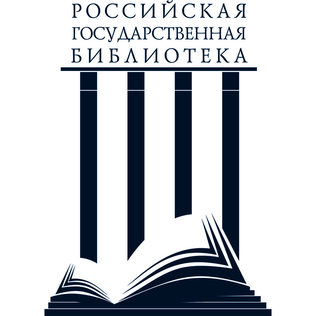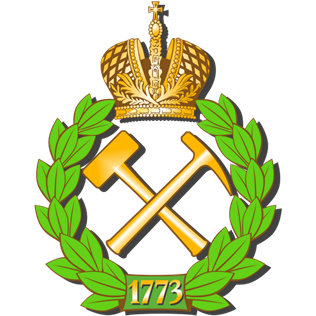
The House of Romanov was the reigning imperial house of Russia from 1613 to 1917.

The Russian Academy of Sciences consists of the national academy of Russia; a network of scientific research institutes from across the Russian Federation; and additional scientific and social units such as libraries, publishing units, and hospitals.

The Moscow Kremlin, or simply the Kremlin, is a fortified complex in the center of Moscow founded by Russian ruling dynasty of Rurikids. Kremlin is overlooking the Moskva River to the south, Saint Basil's Cathedral and Red Square to the east, and the Alexander Garden to the west. It is the best known of the kremlins, and includes five palaces, four cathedrals, and the enclosing Kremlin Wall with Kremlin towers. In addition, within this complex is the Grand Kremlin Palace that was formerly the Tsar's Moscow residence. The complex now serves as the official residence of the President of the Russian Federation and as a museum with almost 3 million visitors in 2017.

St Petersburg University is a Russian public university based in Saint Petersburg. It is the oldest and one of the largest universities in Russia.

The Smolny Institute is a Palladian edifice in St Petersburg that has played a major part in the history of Russia.
The Komarov Botanical Institute of the Russian Academy of Sciences is a leading botanical institution in Russia, It is located on Aptekarsky Island in St. Petersburg, and is named after the Russian botanist Vladimir Leontyevich Komarov (1869–1945). The institute was established in 1931 as merger of the Botanical Garden and the Botanical Museum of the Academy of Sciences.

The State Russian Museum, formerly the Russian Museum of His Imperial Majesty Alexander III, on Arts Square in Saint Petersburg, is the world's largest depository of Russian fine art. It is also one of the largest art museums in the world with total area over 30 hectares.In 2020, due to the COVID-19 pandemic it attracted only 1,203,324 visitors, a drop of 50 percent from 2020, but it still ranked seventh on the list of most-visited art museums in the world.

The Russian State Library is the national library of Russia, located in Moscow. It is the largest in the country and the fifth largest in the world for its collection of books. It was named the V. I. Lenin State Library of the USSR from 1925 until it was renamed in 1992 as the Russian State Library.
The term Soviet Nonconformist Art refers to Soviet art produced in the former Soviet Union from 1953 to 1986 outside of the rubric of Socialist Realism. Other terms used to refer to this phenomenon are "underground art" or "unofficial art".

Saint Petersburg Mining University, is Russia's oldest technical university, and one of the oldest technical colleges in Europe. It was founded on October 21, 1773, by Empress Catherine the Great, who realised an idea proposed by Peter the Great and Mikhail Lomonosov for training engineers for the mining and metals industries. Having a strong engineering profession was seen by many Russian rulers as a vital means of maintaining Russia's status as a great power. As historian Alfred J. Rieber wrote, "The marriage of technology and central state power had a natural attraction for Peter the Great and his successors, particularly Paul I, Alexander I and Nicholas I". All three had had a military education and seen the achievements of the engineers of revolutionary and imperial France, who had reconstructed the great highways, unified the waterways and erected buildings throughout Europe in a more lasting tribute to the French than all of Napoleon's victories.

Grand Duke Vladimir Alexandrovich of Russia was a son of Emperor Alexander II of Russia, a brother of Emperor Alexander III of Russia and the senior Grand Duke of the House of Romanov during the reign of his nephew, Emperor Nicholas II.

The Vladimir Palace was the last imperial palace to be constructed in Saint Petersburg, Russia. It was designed by a team of architects for Alexander II's son, Grand Duke Vladimir Alexandrovich of Russia. Construction work lasted from 1867 to 1872.

The Consulate-General of Denmark in Saint Petersburg is the diplomatic mission of Denmark in Saint Petersburg, Russian Federation. It is located at 13 Bolshaya Alleya on Kamenny Island in Saint Petersburg.

Monaco–Russia relations is the bilateral relationship between the Principality of Monaco and the Russian Federation.
The following is a timeline of the history of the city of Saint Petersburg, Russia.

House with an Arch is a painting by the Russian artist Sergei I. Osipov (1915–1985), executed in 1972 during the one of his visit of Staritsa ancient town and recognized as one of his most famous works in the genre of winter cityscape.
Events from the year 1789 in Russia

The following outline is provided as an overview of and topical guide to Saint Petersburg:














